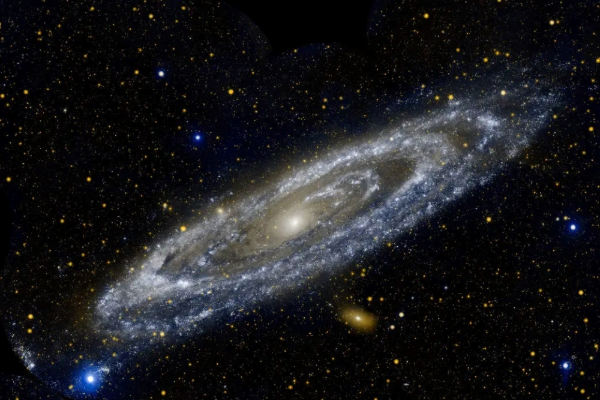October's Night Sky Notes: Catch Andromeda Rising!
- 09/16/2024
Hot stars burn brightly in this new image from NASA's Galaxy Evolution Explorer, showing the ultraviolet side of a familiar face. At approximately 2.5 million light-years away, the Andromeda galaxy, or M31, is our Milky Way's largest galactic neighbor. Credit: NASA
If you’re thinking of a galaxy, the image in your head is probably the Andromeda Galaxy! Studies of this massive neighboring galaxy, also called M31, have played an incredibly important role in shaping modern astronomy. As a bonus for stargazers, the Andromeda Galaxy is also a beautiful sight.

Spot the Andromeda Galaxy! M31’s more common name comes from its parent constellation, which becomes prominent as autumn arrives in the Northern Hemisphere. Surprising amounts of detail can be observed with unaided eyes when seen from dark sky sites. Hints of it can even be made out from light polluted areas. Use the Great Square of Pegasus or the Cassiopeia constellation as guides to find it. Credit: Stellarium Web
Have you heard that all the stars you see at night are part of our Milky Way galaxy? While that is mostly true, one star-like object located near the border between the constellations of Andromeda and Cassiopeia appears fuzzy to unaided eyes. That’s because it’s not a star, but the Andromeda Galaxy, its trillion stars appearing to our eyes as a 3.4 magnitude patch of haze. Why so dim? Distance! It’s outside our galaxy, around 2.5 million light years distant - so far away that the light you see left M31’s stars when our earliest ancestors figured out stone tools. Binoculars show more detail: M31’s bright core stands out, along with a bit of its wispy, saucer-shaped disc. Telescopes bring out greater detail but often can’t view the entire galaxy at once. Depending on the quality of your skies and your magnification, you may be able to make out individual globular clusters, structure, and at least two of its orbiting dwarf galaxies: M110 and M32. Light pollution and thin clouds, smoke, or haze will severely hamper observing fainter detail, as they will for any “faint fuzzy.” Surprisingly, persistent stargazers can still spot M31’s core from areas of moderate light pollution as long as skies are otherwise clear.

Generated version of the Andromeda Galaxy and its companion galaxies M32 and M110. Credit: Stellarium Web
Modern astronomy was greatly shaped by studies of the Andromeda Galaxy. A hundred years ago, the idea that there were other galaxies beside our own was not widely accepted, and so M31 was called the “Andromeda Nebula.” Increasingly detailed observations of M31 caused astronomers to question its place in our universe – was M31 its own “island universe,” and not part of our Milky Way? Harlow Shapley and Heber Curtis engaged in the “Great Debate” of 1920 over its nature. Curtis argued forcefully from his observations of dimmer than expected nova, dust lanes, and other oddities that the “nebula” was in fact an entirely different galaxy from our own. A few years later, Edwin Hubble, building on Henrietta Leavitt’s work on Cepheid variable stars as a “standard candle” for distance measurement, concluded that M31 was indeed another galaxy after he observed Cepheids in photos of Andromeda, and estimated M31’s distance as far outside our galaxy’s boundaries. And so, the Andromeda Nebula became known as the Andromeda Galaxy.

While M31’s disc appears larger than you might expect (about 3 Moon widths wide), its “galactic halo” of scattered stars and gas is much, much larger – as you can see here. In fact, it is suspected that its halo is so huge that it may already mingle with our Milky Way’s own halo, which makes sense since our galaxies are expected to merge sometime in the next few billion years! The dots are quasars, objects located behind the halo, which are the very energetic cores of distant galaxies powered by black holes at their center. The Hubble team studied the composition of M31’s halo by measuring how the quasars’ light was absorbed by the halo’s material. Credits: NASA, ESA, and E. Wheatley (STScI) Source: https://bit.ly/m31halo
These discoveries inspire astronomers to this day, who continue to observe M31 and many other galaxies for hints about the nature of our universe. One of the Hubble Space Telescope’s longest-running observing campaigns was a study of M31: the Panchromatic Hubble Andromeda Treasury (PHAT). Dig into NASA’s latest discoveries about the Andromeda Galaxy, on their Messier 31 page.
Originally posted by Dave Prosper: September 2021
Last Updated by Kat Troche: September 2024



